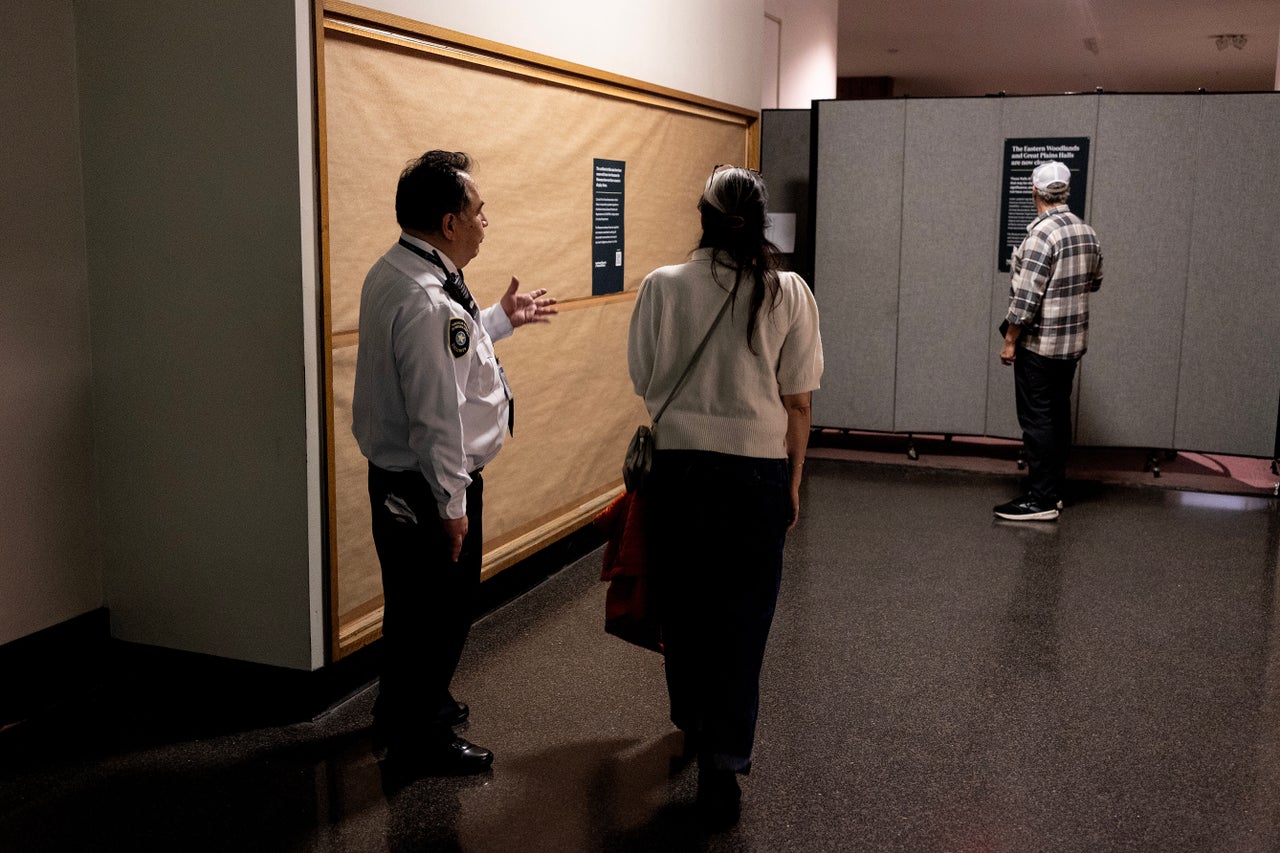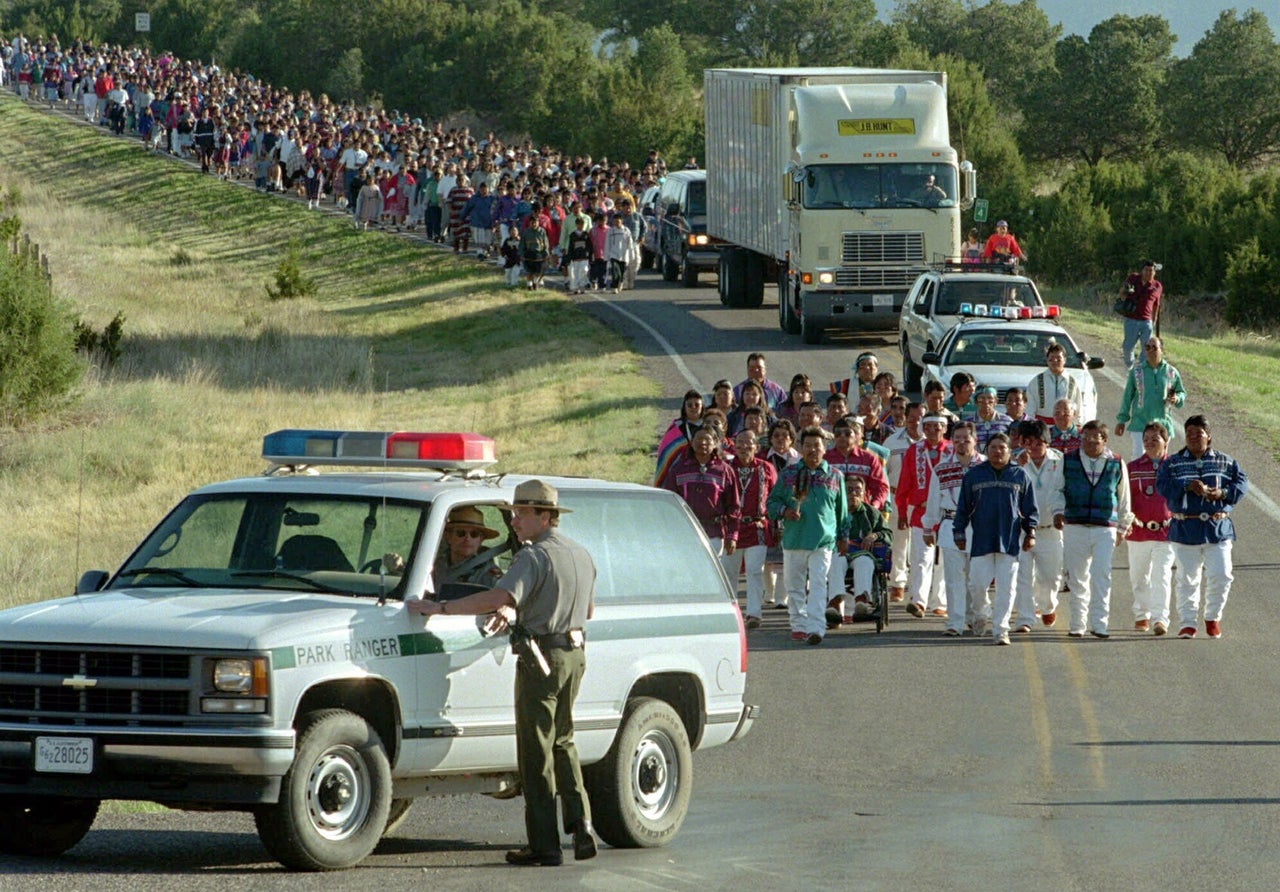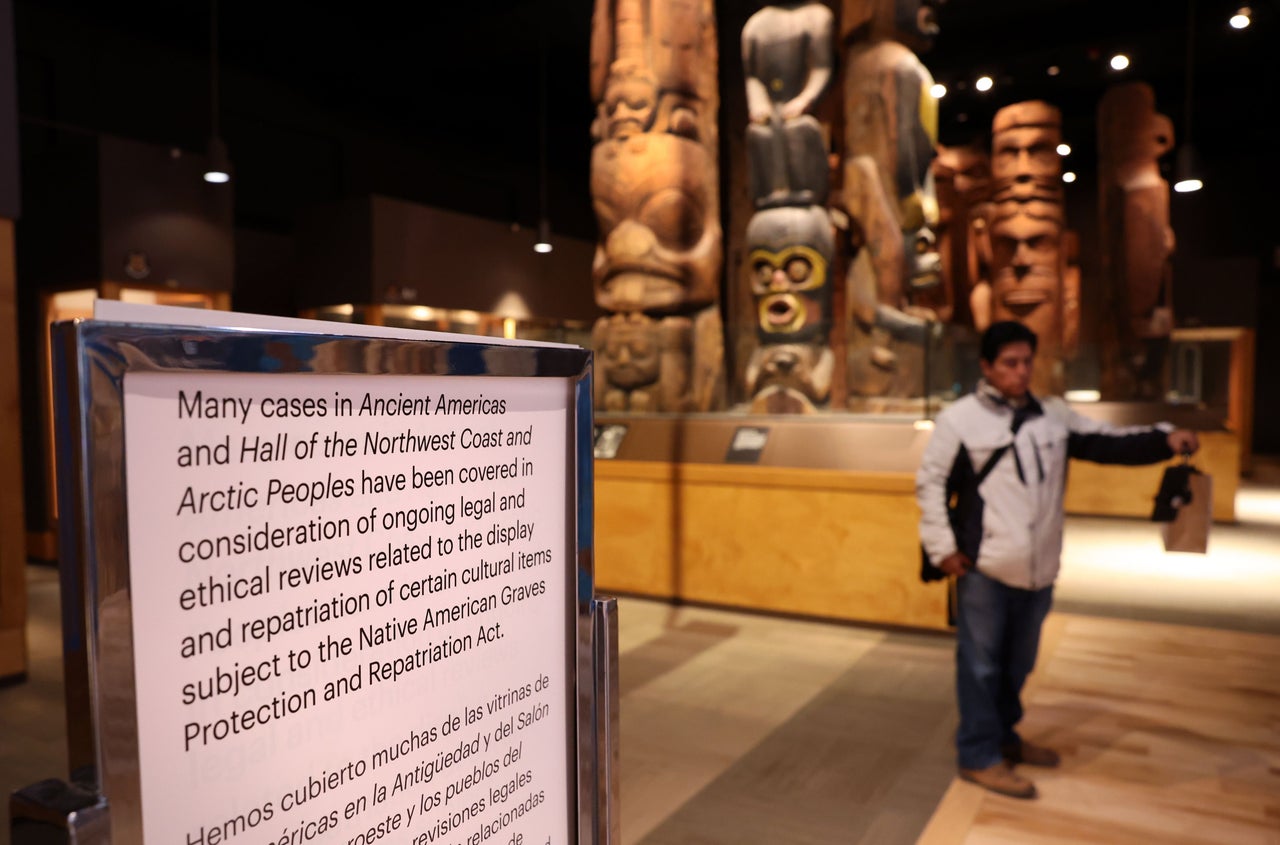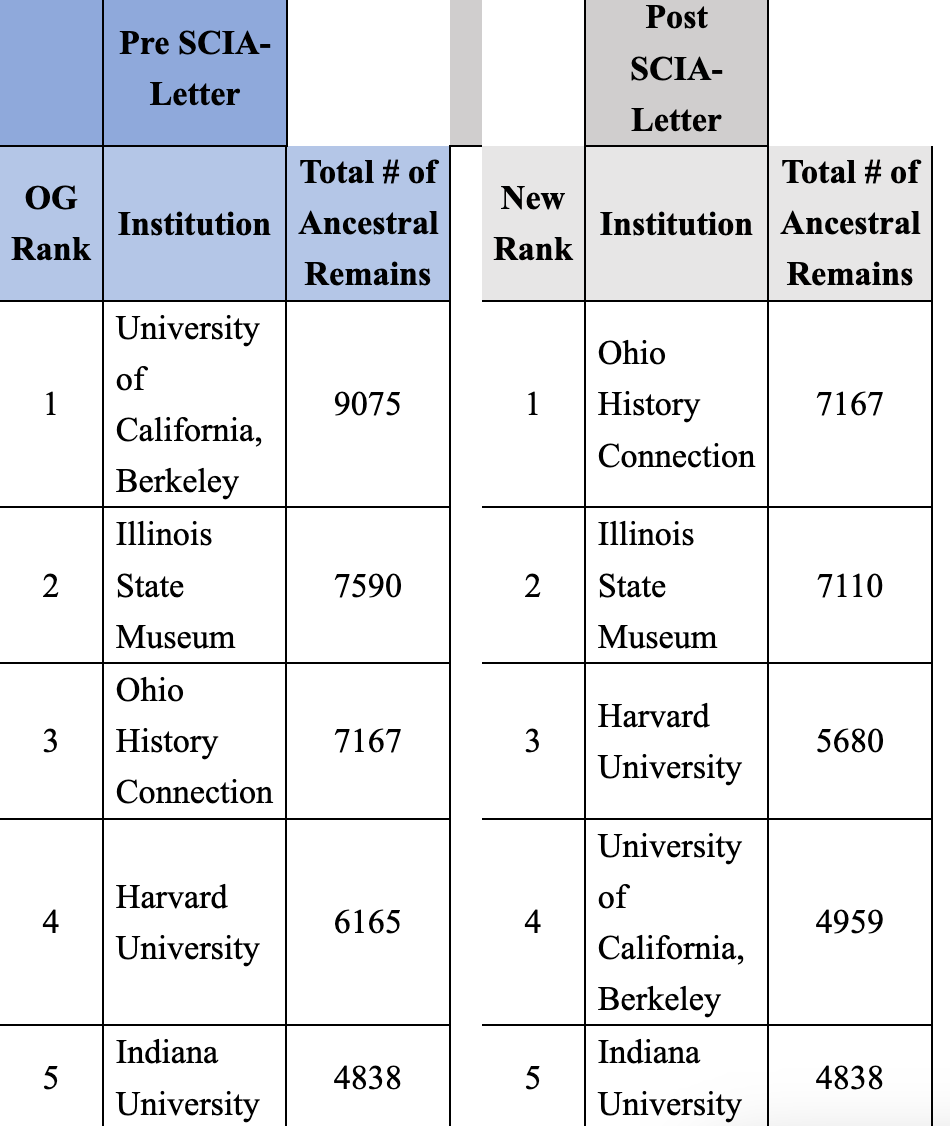WASHINGTON — A couple of months ago, Sen. Brian Schatz (D-Hawaii) walked onto the Senate floor with an unusual plan: public shaming.
Speaking to the C-SPAN cameras, Schatz began listing off the names of universities and museums with large collections of human remains and sacred funerary objects that belong to Native Americans. They were supposed to have been returned decades ago, but weren’t.
“These museums and universities are everywhere,” Schatz fumed in his floor remarks. “The University of Tennessee. The University of Kentucky. The University of Alabama. The University of Arizona. The University of Florida. The University of Missouri-Columbia. The University of Oklahoma. The Center for American Archaeology in Illinois. The University of Texas at Austin. The Milwaukee Public Museum.”
More than 70 institutions around the country are holding on to tens of thousands of human remains — not to mention hundreds of thousands of cultural items — that were largely taken from Native American burial sites in the late 1800s and are now parts of academic collections.
The National Park Service has a public database of which colleges, museums, universities and historical groups have such items in their collections, and how many of each. As of last month, these institutions collectively held the remains of nearly 58,000 Indigenous people.
They appear to be violating the Native American Graves Protection and Repatriation Act of 1990, or NAGPRA, a federal law demanding the “expeditious” return of these items. And some of the institutions with the largest collections are universities that proudly espouse progressive values, like Harvard University and the University of California, Berkeley.
The questions are obvious: Have all of these museums and universities really been breaking the law for more than 30 years? And why haven’t they returned human remains and other sacred items to the people and tribes they belong to?

ProPublica, an investigative journalism outfit, last year did a sweeping probe into which institutions have the biggest collections of these items. Some have since returned ancestral remains and sacred objects to Indigenous groups. Many have not.
Schatz, who chairs the Senate Indian Affairs Committee, has been using his position to go after these universities. He’s held hearings to figure out how Congress can better enforce the 1990 law. He’s led bipartisan letters to the institutions with the biggest collections, demanding answers to why they still haven’t given back thousands of items to Native tribes and groups.
He’s also been trying to humiliate them into action. In his recent floor speech, the Hawaii senator ripped the excuses that some have given for not complying with the law, including a claim by some that Indigenous groups can’t adequately take care of the items that currently sit in institutions’ collections.
“This smells of the worst kind of colonialism with a thin veneer of progressive ideology and verbiage,” Schatz charged. “University provosts and presidents can do all of the land acknowledgements that they want. They can post lengthy statements about equity on their websites and champion any number of progressive causes.
“But that rings hollow when they are, at the same time, clinging onto vast collections of stolen items because of a perverse, patronizing sense of ownership,” he said.
Simply put, all of these institutions could have ― should have ― returned these items decades ago. By and large, they’ve chosen not to.
In a recent interview with HuffPost, Schatz emphasized the context in which this has been happening. Native people have historically had almost everything stolen from them — their land, their water, their language, their children — because of the U.S. government’s policies of termination and then assimilation. The fact that so many universities and museums are holding onto stolen human remains is yet another piece of this broader injustice.
“I think what’s gotten me so irritated is that [these institutions] have acted as if this was some impossible task,” said the Hawaii senator, “either administratively or in terms of determining the lineage or providence of an item.”
But the situation is more complicated.
For one thing, NAGPRA didn’t even require all of these institutions to return these items until Jan. 12, 2024, when the Interior Department put new, game-changing regulations in place.
For the last 30-plus years, under NAGPRA, universities and museums have been creating inventories of their human remains and funerary objects, separating out items that could be culturally affiliated with certain tribes or groups from the items that could not. The government spent decades creating regulations about what to do with items that were culturally unidentifiable. But for items that could be tied to a particular group, the onus has been on Native tribes and groups to file claims. It’s then fallen to universities and museums to work through these claims with these Indigenous groups.
Some institutions have found ways to delay or avoid returning ancestral remains to Native groups, whether it’s been through insufficient consultation with tribes, disrespect for Indigenous peoples’ traditional knowledge, misidentification of items or even allegations of malfeasance.
But the rules just changed. As of January, these schools and museums are required to revise their inventories again ― and to complete the process of returning these items. They have until January 2029 to report on and return everything they have.

Bureaucracy isn’t the only thing that’s gummed this up, said Valerie Grussing, executive director of the National Association of Tribal Historic Preservation Officers.
Sometimes tribes don’t have museums or cultural centers suited for housing these items. Sometimes tribes disagree with each other over which items are affiliated with which tribe. Sometimes one tribe may want to bring an item home and bury it, while another tribe with an overlapping claim to that item doesn’t want to do that. Sometimes a tribe may work out an agreement with a museum, where items may stay at the museum but tribal members may periodically remove them for a ceremony.
“I don’t mean to downplay cases where there have been bad actors and institutional resistance,” said Grussing, “but that’s not the whole picture.”
There’s also the predictable problem of money, or lack thereof.
Some tribal historic preservation officers are tasked with carrying out NAGPRA, and they don’t have any dedicated federal funds for doing this. Beyond that, the new NAGPRA regulations in January require Native tribes, for the first time, to respond to excavations and discoveries on tribal lands. But tribes aren’t getting any federal funding to do that, either.
Grussing’s organization estimates that the cost for tribes to comply with NAGPRA’s new requirements on excavations and discoveries is $40 million a year for the next five years. That’s in stark contrast to the Interior Department’s estimate of $12.4 million a year to cover all costs for everyone to comply, including universities and museums, along with tribes.
Of that $12.4 million, the Interior Department also asked in its latest budget request that $3.7 million be set aside for its own NAGPRA compliance efforts, meaning the department would take more than one-third of that pot of money set up for all tribes and institutions.
Still another problem is that there don’t appear to be any real consequences for violating NAGPRA. In its annual report to Congress last year, the National Park Service said it received 74 allegations of violations that it either hadn’t investigated or finished investigating. The last time the Park Service determined that someone failed to comply with NAGPRA was 2016.
“Basically, they’re not doing civil penalties right now,” said C. Timothy McKeown, a pro bono repatriation adviser for the National Association of Tribal Historic Preservation Officers.
McKeown previously worked for the National Park Service for 18 years and also assisted the Department of Justice on tribal trust cases for 10 years. He currently serves on the Interior Department’s NAGPRA advisory committee.
In 2023, this committee finalized its report to Congress, asking lawmakers to direct the Government Accountability Office to investigate the lack of NAGPRA civil penalties being issued. The Interior Department still hasn’t sent this report to Congress for some reason.
An Interior Department spokesperson declined to comment.
National Park Service spokesperson Jordan Fifer said the agency can’t comment on active investigations. But of the 74 allegations of NAGPRA violations that the service has received, he said, all are in various stages of open investigations.
“NPS is committed to thorough investigations, and there are a number of possible resolutions cases can take,” Fifer said, noting the 2021 hire of a full-time NAGPRA investigator has helped clear a backlog of investigations.
Still, the National Park Service has only issued about $60,000 in civil penalties, in total, in the 30-plus years since NAGPRA became law. The new January regulations did increase the base amount of a penalty to $7,475.
For the universities and museums that haven’t been working in good faith to comply with NAGPRA, the new January regulation will force them to come out from hiding behind the bureaucracy, Grussing said.
“They could have worked to do what’s right before the Interior Department had to make it required,” said the tribal historic preservation executive. “Some of them were. It’s not that those discussions weren’t happening in some places. But, they weren’t happening in all places.”

There are signs of a paradigm shift.
The Smithsonian Institution, which has never been subject to NAGPRA, has roughly 30,000 skeletons in its collections that belong to Indigenous people from around the world. It announced this year that it will be taking a new approach to repatriation: If the Smithsonian can’t prove that it obtained human remains with voluntary consent from the deceased or their next of kin for the purpose of science or display, by 2030, it will return or rebury all of them.
“The idea they’ve come forward with has switched the game around,” McKeown said. “Instead of evaluating claims that come in, they are assuming if they can’t prove they have right of possession, all must go. That is monumental.”
It doesn’t hurt that, at the same time, a U.S. senator is needling individual universities and museums about needing to do better.
Last April, when Schatz led bipartisan letters to the institutions with the biggest collections of Native American remains, he made those letters public. They went to the presidents of University of California at Berkeley and Harvard, as well as Illinois State Museum, Indiana University and the Ohio History Connection.
Some responded with real action. The University of California at Berkeley has since reduced the number of culturally unidentifiable remains in its collection by 45%. Harvard also began returning items, and recently pledged to cover travel expenses for Native leaders to come to the school and help navigate the process of transferring items to their rightful places.
Perhaps seeing the writing on the wall, institutions like the American Museum of Natural History and the Field Museum in Chicago have since announced steps to speed up their efforts to comply with the law, too.
There are, of course, others that are still holding onto everything in their collections. Two of the five institutions targeted by Schatz last year, Indiana University and Ohio History Connection, haven’t returned anything to Indigenous groups, according to the NAGPRA database.
Ohio History Connection currently holds the largest number of remains in the country, with its 7,167 ancestral remains. Indiana University is ranked fifth, with its 4,838 ancestral remains.

Both of these institutions responded to Schatz’s letters last year with reasons for keeping these items in their collections. HuffPost obtained copies of their letters.
Megan Wood, executive director and CEO of Ohio History Connection, said this museum has been “conducting active consultations” with tribes for the last 10 to 15 years to help them make claims and bury ancestors.
“From communicating with our Tribal Partners, we have learned repatriation is not simply reburying the remains of the Ancestors,” Wood said. “I agree the Ancestors have waited on shelves for far too long; but now that we are proactively doing the work, we must do it correctly.”
Fred Cate, who at the time was the vice president for research at Indiana University, similarly emphasized the importance of ongoing consultations with tribes.
“While Indiana University is committed to repatriating as expeditiously as possible, we are also mindful of the desires of our tribal partners,” Cate said. “As Miami Tribe of Oklahoma’s legal counsel Joseph Halloran stated in the January 13, 2023, public comment session aimed at discussing the newly proposed NAGPRA regulations, ‘We don’t want speed, we want justice.’”
HuffPost reached out to both of these institutions on Friday for further comment.
“We’re being patient and consistent in our commitment to repatriation,” Neil Thompson, a spokesperson for Ohio History Connection, said Monday. “These relationships that we build with our tribal partners have been invaluable to conducting this work together.”
On Wednesday, Indiana University spokesperson Mark Bode pointed to efforts the university has been making to comply with NAGPRA, including an upcoming summer training to teach coordinators about the law and best practices.

Schatz last month sent out more bipartisan letters to the next 11 institutions with the largest collections of Native American human remains, demanding they comply with NAGPRA. The University of Kentucky, the University of Missouri at Columbia and the University of Texas at Austin are among them.
“As Senators and Members of the U.S. Senate Committee on Indian Affairs, we write to express our grave concern over recent reports that institutions of higher learning such as yours have failed their statutory mandate to ‘expeditiously return’ cultural items and ancestral remains of Native Americans pursuant to the Native American Graves Protection and Repatriation Act of 1990,” reads the March 1 letter to Jay Hartzell, president of the University of Texas at Austin.
HuffPost obtained copies of these letters, and their text is the same.
There is simply “no legitimate reason” for institutions to hold onto Native American remains, Schatz told HuffPost. “We can do this the easy way, or we can do this the hard way.”
“We do have subpoena power,” he added. “I don’t think anybody wants to get mixed up in a legal process.”
